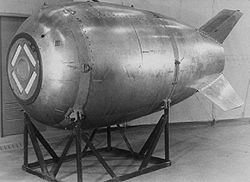
Mark 4 nuclear bomb
Encyclopedia

The Mark 4 was based on the earlier Mark 3 Fat Man
Fat Man
"Fat Man" is the codename for the atomic bomb that was detonated over Nagasaki, Japan, by the United States on August 9, 1945. It was the second of the only two nuclear weapons to be used in warfare to date , and its detonation caused the third man-made nuclear explosion. The name also refers more...
design, used in the Trinity test
Trinity test
Trinity was the code name of the first test of a nuclear weapon. This test was conducted by the United States Army on July 16, 1945, in the Jornada del Muerto desert about 35 miles southeast of Socorro, New Mexico, at the new White Sands Proving Ground, which incorporated the Alamogordo Bombing...
and the bombing of Nagasaki
Atomic bombings of Hiroshima and Nagasaki
During the final stages of World War II in 1945, the United States conducted two atomic bombings against the cities of Hiroshima and Nagasaki in Japan, the first on August 6, 1945, and the second on August 9, 1945. These two events are the only use of nuclear weapons in war to date.For six months...
. The Mark 3 design was essentially handmade and designed as an emergency wartime expedient design; the Mark 4 utilized essentially the same basic design (materials, dimensions of the nuclear core and explosive components) but reengineered the whole design to be safer and easier to produce. The basic ideal was to "GI-proof" otherwise sensitive nuclear weapons.
The Mark 4 was 60 inches (1.5 m) in diameter and 128 inches (3.3 m) long, the same basic dimensions as Mark 3. It weighed slightly more at 10800 to 10900 lb (4,898.8 to 4,944.2 kg) depending on the specific Mark 4 version (Mark 3 weighed 10200 lb (4,626.6 kg)).
In addition to being easier to manufacture, the Mark 4 introduced the concept of in flight insertion or IFI, a weapons safety concept which was used for a number of years. An IFI bomb has either manual or mechanical assembly which keeps the nuclear core stored outside the bomb until close to the point that it may be dropped. To arm the bomb, the fissile nuclear materials are inserted into the bomb core through a removable segment of the explosive lens assembly, which is then replaced and the weapon closed and armed.
Mark 4 models used composite uranium
Uranium
Uranium is a silvery-white metallic chemical element in the actinide series of the periodic table, with atomic number 92. It is assigned the chemical symbol U. A uranium atom has 92 protons and 92 electrons, of which 6 are valence electrons...
and plutonium
Plutonium
Plutonium is a transuranic radioactive chemical element with the chemical symbol Pu and atomic number 94. It is an actinide metal of silvery-gray appearance that tarnishes when exposed to air, forming a dull coating when oxidized. The element normally exhibits six allotropes and four oxidation...
fissile pits
Pit (nuclear weapon)
The pit is the core of an implosion weapon – the fissile material and any neutron reflector or tamper bonded to it. Some weapons tested during the 1950s used pits made with U-235 alone, or in composite with plutonium, but all-plutonium pits are the smallest in diameter and have been the standard...
. The exact pit assemblies were common with several other US nuclear weapons, the Type C and Type D pit assemblies.
Various versions of the Mark 4 had explosive yields of 1, 3.5, 8, 14, 21, 22, and 31 kilotons (4 to 130 TJ
Joule
The joule ; symbol J) is a derived unit of energy or work in the International System of Units. It is equal to the energy expended in applying a force of one newton through a distance of one metre , or in passing an electric current of one ampere through a resistance of one ohm for one second...
).
A total of 550 Mark 4 nuclear weapons were produced.
The Mark 4 was succeeded by the Mark 6 nuclear bomb
Mark 6 nuclear bomb
The Mark 6 nuclear bomb was an American nuclear bomb based on the earlier Mark 4 nuclear bomb and its predecessor, the Mark 3 Fat Man nuclear bomb design.The Mark 6 was produced from 1951-1955 and saw service until 1962...
, which was generally similar but much improved.
W4 missile warhead
A variant called the W4, intended for use on the Snark missile, was designed but never built. The W4 design was cancelled in 1951.See also
- List of nuclear weapons
- Mark 3 Fat ManFat Man"Fat Man" is the codename for the atomic bomb that was detonated over Nagasaki, Japan, by the United States on August 9, 1945. It was the second of the only two nuclear weapons to be used in warfare to date , and its detonation caused the third man-made nuclear explosion. The name also refers more...
- SM-62 Snark missile
- Mark 6 nuclear bombMark 6 nuclear bombThe Mark 6 nuclear bomb was an American nuclear bomb based on the earlier Mark 4 nuclear bomb and its predecessor, the Mark 3 Fat Man nuclear bomb design.The Mark 6 was produced from 1951-1955 and saw service until 1962...
External links
- Allbombs.html list of all US nuclear warheads at nuclearweaponarchive.org

